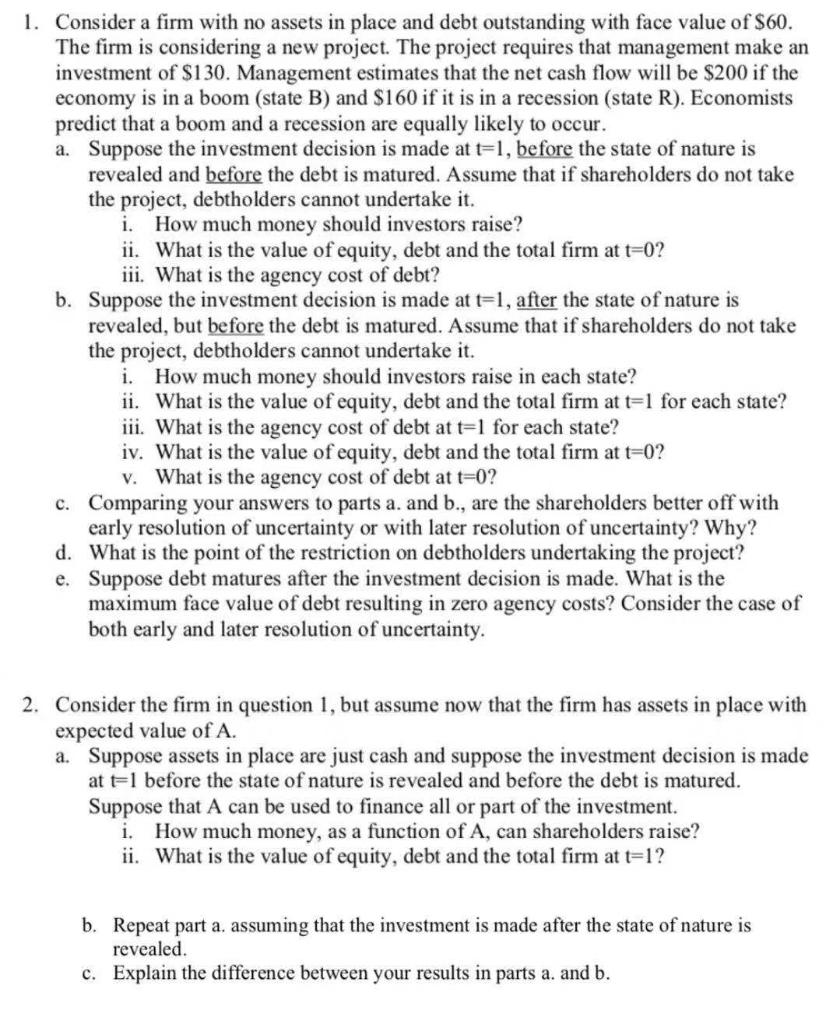
1. Consider a firm with no assets in place and debt outstanding with face value of $60. The firm is considering a new project. The project requires that management make an investment of $130. Management estimates that the net cash flow will be $200 if the economy is in a boom (state B) and $160 if it is in a recession (state R). Economists predict that a boom and a recession are equally likely to occur. a. Suppose the investment decision is made at t=1, before the state of nature is revealed and before the debt is matured. Assume that if shareholders do not take the project, debtholders cannot undertake it. i. How much money should investors raise? ii. What is the value of equity, debt and the total firm at t=0? iii. What is the agency cost of debt? b. Suppose the investment decision is made at t=1, after the state of nature is revealed, but before the debt is matured. Assume that if shareholders do not take the project, debtholders cannot undertake it. i. How much money should investors raise in each state? ii. What is the value of equity, debt and the total firm at t=1 for each state? iii. What is the agency cost of debt at t=l for each state? iv. What is the value of equity, debt and the total firm at t=0? v. What is the agency cost of debt at t=0? c. Comparing your answers to parts a. and b., are the shareholders better off with early resolution of uncertainty or with later resolution of uncertainty? Why? d. What is the point of the restriction on debtholders undertaking the project? e. Suppose debt matures after the investment decision is made. What is the maximum face value of debt resulting in zero agency costs? Consider the case of both early and later resolution of uncertainty. 2. Consider the firm in question 1, but assume now that the firm has assets in place with expected value of A. a. Suppose assets in place are just cash and suppose the investment decision is made at El before the state of nature is revealed and before the debt is matured. Suppose that A can be used to finance all or part of the investment. How much money, as a function of A, can shareholders raise? ii. What is the value of equity, debt and the total firm at t=1? i. b. Repeat part a. assuming that the investment is made after the state of nature is revealed. c. Explain the difference between your results in parts a. and b. 1. Consider a firm with no assets in place and debt outstanding with face value of $60. The firm is considering a new project. The project requires that management make an investment of $130. Management estimates that the net cash flow will be $200 if the economy is in a boom (state B) and $160 if it is in a recession (state R). Economists predict that a boom and a recession are equally likely to occur. a. Suppose the investment decision is made at t=1, before the state of nature is revealed and before the debt is matured. Assume that if shareholders do not take the project, debtholders cannot undertake it. i. How much money should investors raise? ii. What is the value of equity, debt and the total firm at t=0? iii. What is the agency cost of debt? b. Suppose the investment decision is made at t=1, after the state of nature is revealed, but before the debt is matured. Assume that if shareholders do not take the project, debtholders cannot undertake it. i. How much money should investors raise in each state? ii. What is the value of equity, debt and the total firm at t=1 for each state? iii. What is the agency cost of debt at t=l for each state? iv. What is the value of equity, debt and the total firm at t=0? v. What is the agency cost of debt at t=0? c. Comparing your answers to parts a. and b., are the shareholders better off with early resolution of uncertainty or with later resolution of uncertainty? Why? d. What is the point of the restriction on debtholders undertaking the project? e. Suppose debt matures after the investment decision is made. What is the maximum face value of debt resulting in zero agency costs? Consider the case of both early and later resolution of uncertainty. 2. Consider the firm in question 1, but assume now that the firm has assets in place with expected value of A. a. Suppose assets in place are just cash and suppose the investment decision is made at El before the state of nature is revealed and before the debt is matured. Suppose that A can be used to finance all or part of the investment. How much money, as a function of A, can shareholders raise? ii. What is the value of equity, debt and the total firm at t=1? i. b. Repeat part a. assuming that the investment is made after the state of nature is revealed. c. Explain the difference between your results in parts a. and b







